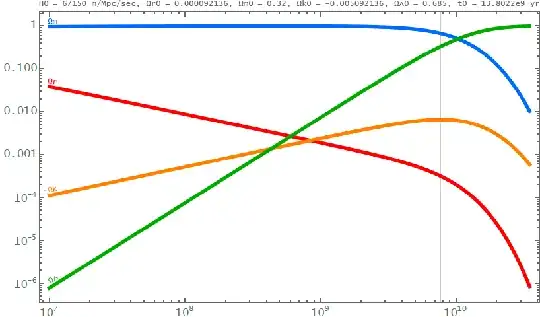For flat universe, the Friedmann equation is given by:
$$ H^2 = \frac{8\pi G}{3} ~~ \left( \rho_m + \rho_r + \rho_\Lambda \right). $$
From this thread:
What is the equation for the scale factor of the universe..
we can get the scale factor. As I understand using that:
$ \rho_{m} = \frac{constant}{a^3}= \frac{\rho_{m0}}{a^3} ,~ \rho_{r} = \frac{constant}{a^4} = \frac{\rho_{r0}}{a^4} $
Then:
$ \Omega_{m0} = \frac{8 \pi G}{3H_0^2} ~\rho_{m0}, ~\Omega_{r0} = \frac{8 \pi G}{3H_0^2} ~\rho_{r0},~ \Omega_{\Lambda0} = \frac{8 \pi G}{3H_0^2} ~\rho_{\Lambda0}, $ which gives Friedmann equation by:
$$ H^2 = H^2_0~~ \left( \Omega_{m0} a^{-3}+ \Omega_{r0} a^{-4} + \Omega_{\Lambda0} \right). $$ I’m a little confused how to get the total density parameter $\Omega_{total} = \Omega_{m} + \Omega_{r} + \Omega_{\Lambda} $ as a function of time?
For instance as in this paper arXiv:1709.06497v2 figure (2).
Any help is appreciated!
